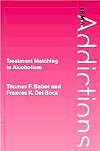Thomas F. Babor, Ph.D., and Frances K. Del Boca, Ph.D., Editors
December 2002; Hardback; 292 pages, 16 tables, and 20 figures; ISBN: 0521651123
Description
 Project MATCH was a large-scale treatment evaluation study established by the U.S. National Institute on Alcohol Abuse to determine whether the treatment of alcoholism could be improved by matching different types of alcoholics with the most appropriate kinds of treatment. This book, edited by the two principal investigators, is the first comprehensive report of Project MATCH, the largest treatment study ever conducted with alcoholics. It describes the rationale, methods, results and implications of the study, and presents new findings about how treatment works, for whom it is most effective, and who does best in different kinds of treatment. It also offers some of the first scientific evidence on the effectiveness of Alcoholics Anonymous. The audience for this book is broad, including researchers, clinicians and policy makers in the field of alcoholism and addiction.
Project MATCH was a large-scale treatment evaluation study established by the U.S. National Institute on Alcohol Abuse to determine whether the treatment of alcoholism could be improved by matching different types of alcoholics with the most appropriate kinds of treatment. This book, edited by the two principal investigators, is the first comprehensive report of Project MATCH, the largest treatment study ever conducted with alcoholics. It describes the rationale, methods, results and implications of the study, and presents new findings about how treatment works, for whom it is most effective, and who does best in different kinds of treatment. It also offers some of the first scientific evidence on the effectiveness of Alcoholics Anonymous. The audience for this book is broad, including researchers, clinicians and policy makers in the field of alcoholism and addiction.
Contributors
John P. Allen, Thomas F. Babor, Margaret E. Mattson, Ronald M. Kadden, Frances K. Del Boca, Richard Fuller, Gerard J. Connors, William R. Miller, Raymond F. Anton, J. Scott Tonigan, Dennis M. Donovan, Kathleen M. Carroll, Carlo C. DiClemente, Bruce J. Rounsaville, Allen Zweben, Bonnie McRee, Richard Longabaugh, Philip W. Wirtz, Robert Stout, Joseph Carbonari, Robert Rychtarik, Mark D. Litt, Ned L. Cooney, Carrie L. Randall, Karen Steinberg, Ron Cisler
Chapter Contents
Part I Design and Implementation
- Matching alcoholism treatment to client heterogeneity: The genesis of project MATCH. John P. Allen, Thomas F. Babor, Margaret E. Mattson and Ronald M. Kadden. (Pp. 3-14)
- Planning a multisite matching trial: Organizational structure and research design. Frances K. Del Boca, Margaret E. Mattson, Richard Fuller and Thomas F. Babor. (Pp. 15-28)
- Clinical assessment: measuring matching characteristics and treatment outcomes. Gerard J. Connors, William R. Miller, Raymond F. Anton and J. Scott Tonigan. (Pp. 29-41)
- Therapies for matching: selection, development, implementation, and costs. Dennis M. Donovan, Kathleen M. Carroll, Ronald M. Kadden, Carlo C. DiClemente and Bruce J. Rounsaville. (Pp. 42-61)
- Client characteristics and implementation of the research protocol. Allen Zweben, Frances K. Del Boca, Margaret E. Mattson and Bonnie McRee. (Pp. 62-80)
- The matching hypotheses: rationale and predictions. Ronald M. Kadden, Richard Longabaugh and Philip W. Wirtz. (Pp. 81-102)
Part II Findings
- Primary treatment outcomes and matching effects: Outpatient arm. Robert Stout, Frances K. Del Boca, Joseph Carbonari, Robert Rychtarik, Mark D. Litt and Ned L. Cooney. (105-134)
- Primary treatment outcomes and matching effects: Aftercare arm. Carrie L. Randall, Frances K. Del Boca, Margaret E. Mattson, Robert Rychtarik, Ned L. Cooney, Dennis M. Donovan, Richard Longabaugh and Philip W. Wirtz. (Pp.135-149)
- Treatment effects across multiple dimensions of outcome. Thomas F. Babor, Karen Steinberg, Allen Zweben, Ron Cisler, Robert Stout, J. Scott Tonigan, Raymond F. Anton and John P. Allen. (Pp. 150-165)
- A look inside treatment: therapist effects, the therapeutic alliance, and the process of intentional behavior change. Carlo C. DiClemente, Kathleen M. Carroll, William R. Miller, Gerard J. Connors and Dennis M. Donovan. (Pp. 166-183)
- Participation and involvement in Alcoholics Anonymous. J. Scott Tonigan, Gerard J. Connors and William R. Miller. (Pp. 184-204)
Part III Conclusions and Implications
- Summary and conclusions. William R. Miller and Richard Longabaugh. (Pp. 207-221)
- Clinical and scientific implications of project MATCH. Ned L. Cooney, Thomas F. Babor, Carlo C. DiClemente and Frances K. Del Boca. (Pp. 222-237)